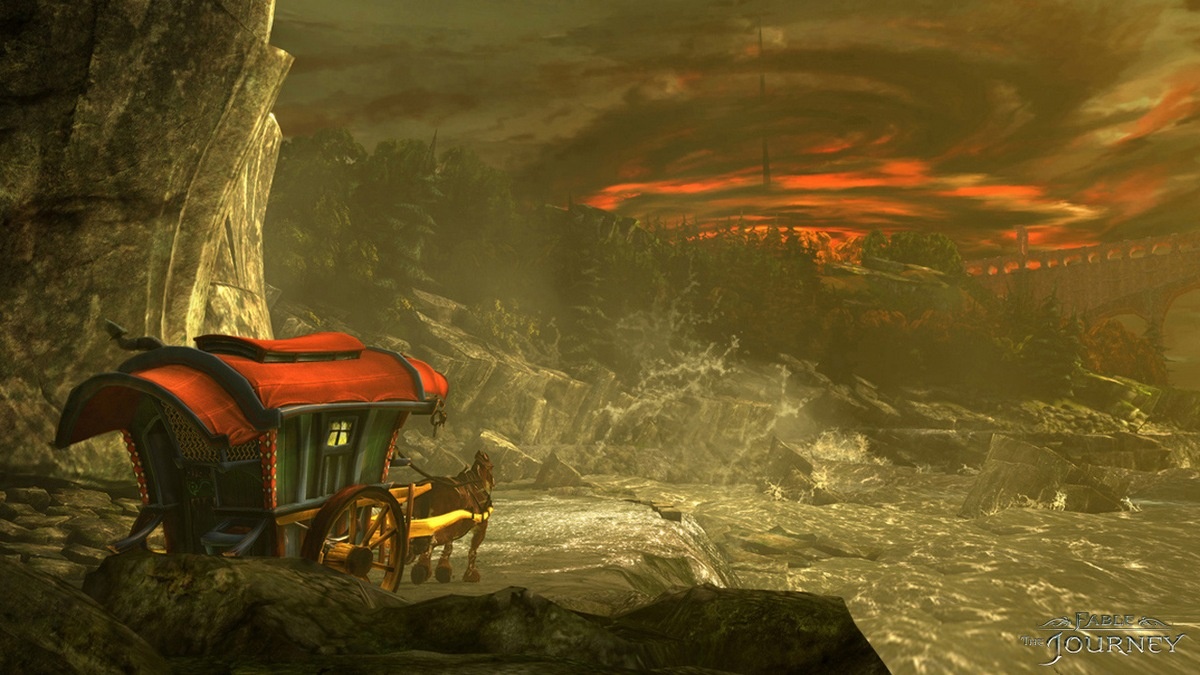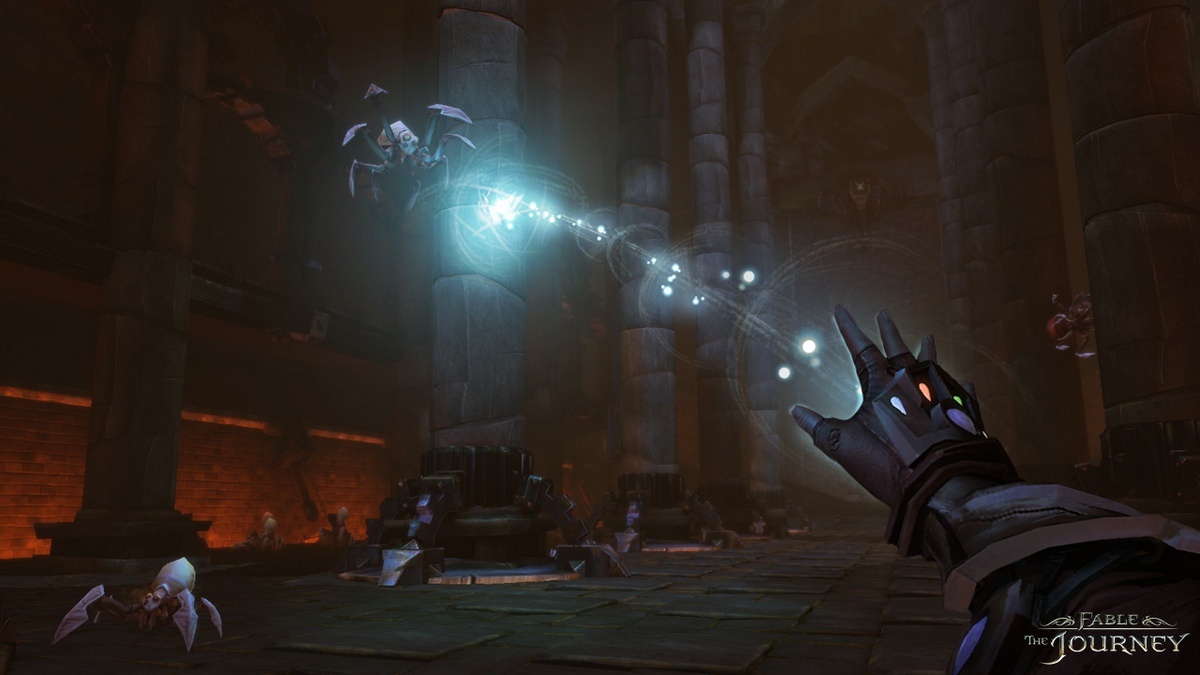Fable: The Journey and Molyneux's Lionhead legacy
Peter Molyneux may be officially out of the picture, but Fable: The Journey is unmistakably his flight of fancy.
When Peter Molyneux quit Lionhead and Microsoft in March, the move fit the general pattern of his illustrious and intermittently controversial career. He founded Bullfrog in 1987, sold it to Electronic Arts in 1995, and left in 1997 to found Lionhead. Lionhead was sold to Microsoft in 2006, and now Molyneux turns his attention to 22 Cans, a fresh independent venture.
The way folks at Lionhead tell it, then, Peter Molyneux's departure was no great surprise. "I've worked with Peter for 23 years," says Gary Carr, creative director. "I knew at some point he'd want to go and do something different. I think he wants to try some new things." Nor was it an upheaval for Fable: The Journey, they say, with most of the design work completed before he left for pastures new.
"He obviously had a big influence on The Journey and continues to have a big influence on The Journey because he's still here as a consultant," says Ben Brooks, senior scripter on Molyneux's final Lionhead project. "The kind of thing he's doing now as a consultant, reviewing the game and providing feedback, is exactly what Peter would be doing at this stage of any Fable game."

At the same time, you wonder if everyone doesn't also breathe a little easier without Molyneux on hand at media gatherings, where the assembled press are wont to take as ironclad promises what turn out to have been just ambitious musings. The pledge that emotion in your voice will modify the magic spells you cast with Kinect hand gestures, for instance, which gets nary a mention in our recent visit to Lionhead's Guildford studio. Or those emphatic assurances that Fable: The Journey is not, by any means, on rails.
Time in the game is divided between sections spent steering a horse-drawn cart and sections on foot which are, in all reasonable definitions of "on rails", on rails. It is a blow to those who hopefully expected freedom of movement to be added at a later date, as suggested by Molyneux in the game's previous showings, but is not, or shouldn't be, an automatic death blow to Fable: The Journey. It's just another way in which The Journey is, mechanically speaking, poles apart from any Fable title before it.
Where Fables I through III were free-roaming, open world adventures, The Journey is a journey: a linear, cross-country jaunt towards The Spire, the mystical edifice established in previous games. Where earlier Fables emphasised individually customised hero characters, The Journey gives us a fully defined hero in Gabriel, the gypsy-like youth at the reigns of its horse-drawn transport. Where the last game's endearing animal companion was a dog, The Journey's is Seren, the glossy shire horse tethered to Gabriel's cart. And all of it is drawn in a first-person view, not a third-person view, as best suits the key difference between this game and other Fables: Kinect.
There's no place for the traditional controller in Fable: The Journey. This is a pure Kinect game, built wholly around the Xbox's controller-free system. Its development roots at Lionhead mingle with those of Project Milo, the interactive virtual boy unveiled at Kinect's E3 public debut in 2009, destined never to grow beyond a tech demo--one sequence we play involves leaning over a magical pool, ruffling its surface with outstretched hands, not unlike the pool in the Milo demo.
Thankfully, this "nine- or ten-hour" all-Kinect game is played sitting, with the horse-drawn sequences controlled by tugging left or right on the reigns, cracking both to accelerate, or pulling them up and back to halt. The on-foot action means using each hand to cast spells that include a fireball, a force push, and a blade-summoning number Fable fans will recognise from previous instalments.

The Kinect controls work decently, although the game is also forgiving, generously intuiting the intent of less precise waving, at least in the early stages we sampled. However protected you feel, though, it is possible to die.
When Theresa (the blind psychic Fable fans will, again, recognise from previous instalments) stumbles onto the road near Gabriel, pursued by a nebulous dark force, he bundles her onto his cart's passenger seat. So begins one of the game's chase sequences, in which malevolent lava pours onto the path from either side, and you must guide Seren along the safe route through it. Seren's health bar is eaten away by collisions with the lava.
Elsewhere, she can also be damaged by being run at full speed over rocky patches, or stuck with enemy arrows. The latter can be extracted in the first-person horse care segments, in which Gabriel pulls over to tend to his horse's wounds.
Fable: The Journey benefits from its main means of player movement being a horse-drawn cart, in that Kinect lag or imprecision between gesture and reaction makes sense, mimicking as it does the less-than-instant, natural response of a horse. But it's not as though the controls fall apart away from Seren, in the cavern- and tunnel-based on-rails segments we played.
Both the spells unlocked in our demo, a magic missile and the force push, can be cast (with the expected pointing gesture) and then aftertouched towards a target, letting you curve magic around obstacles with a neat flick. Similarly, the force push can also be used like a magic leash for remotely manipulating scenery, tugging spiky stalactites down from the ceiling to squash bug-like beasties.
It's all worlds away from the free-roaming action role-playing long associated with the franchise, but there's an unmistakable Fable flavour to the rich, cartoony styling and quirky dialogue that will either delight franchise fans or frustrate those who wanted nothing more than a Fable IV. Studio head and co-founder Mark Webley insists the uniquely charming world of Albion, open or otherwise, is the true heart of Fable, along with the strong storytelling for which the series is known.
"You're actually seeing a lot more of the world of Albion than you typically would in a Fable game," says Webley. "While you don't have a big open world, we're creating big open spaces like Bower Lake and all around it. Here, you're seeing canyons, caves, different environments we've never shown players before. The fact we can drive people through them with our story is pretty cool."
That much is true; the way Seren and Gabriel are channelled along lakeside roads and through small settlements lets Lionhead for the first time give players a first-person guided tour through Albion. It's sensible, provable assertions like these we can expect from the Guildford studio, now that Molyneux has moved on, even if The Journey is still clearly a Molyneux flight of fancy. There are Molyneux ambitions stamped all over it--as a long-form, story-based, all-Kinect game that overturns the mechanics of a bestselling franchise to find its own way.
Gary Carr tells us he expects Lionhead and 22 Cans, Molyneux's new venture, to co-exist in a state of "friendly rivalry", and that Lionhead aims for nothing less than its "next 15 years to be better than the last 15 years". And with Molyneux presently popping in once a week in his consultant role, his presence is still very much felt. "He's only up the road, by the way," says Carr. "He's only three offices up there. He comes down, we still play football and go running, all those kinds of things."
Got a news tip or want to contact us directly? Email news@gamespot.com
Join the conversation